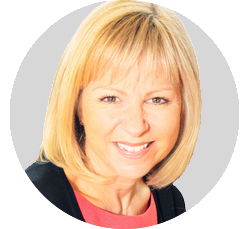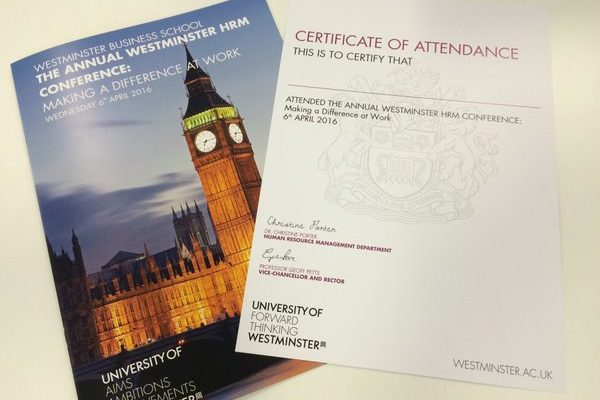Each year Westminster Business School Department of HRM holds its annual HRM Conference, primarily for the benefit of those studying the Human Resource Management MA. As well as guest speakers and industry experts, alumni are also invited to network and learn with current students. The theme of this year’s event was Making a Difference At Work – something presumably, most of us are keen to do. Chaired by Professor Janet Druker of Westminster, guest speakers included Ted Smith, People and Facilities Director at the Wellcome Trust, Linda Kennedy‐McCarthy, Group HR Director of SIG plc, Hilary Scarlett of Scarlett and Grey, and Cathy Brown, Executive Director, of Engage for Success.
 Getting stuff done in HR
Getting stuff done in HR
This was the topic of the first speaker, Ted Smith. Ted is currently People and Facilities Director of the Wellcome Trust and has a varied professional background which has included being Group HR Director for the Medical Research Council and Vice President HR for the information systems and research teams at GlaxoSmithKline. Ted was full of great knowledge and advice for fellow HR professionals. Critically for our students, Ted highlighted the benefits of putting theory learnt in a classroom into practice. Taking us through the Transition Curve and Maslow’s Hierarchy of Needs, Ted showed us how to use these tools within a HR setting. Key roles that he identified in HR included helping people cope with change, resolving or calming conflict and understanding mental health and the importance of home-life issues. Changing focus slightly, Ted continued his session with a talk about making your own luck – how HR professionals can be proactive in improving their employability and moving up the career ladder. Here are some of his tips:
- Put yourself forward!
- Volunteer both in-house and outside
- Get involved in projects
- Offer to help
- Apply for internal roles
- Gain experience of presentations – putting them together and presenting
- Mentor and be mentored
- Utilise the power of LinkedIn!
Concluding his presentation with a Q&A session, Ted also explained that as part of the role of looking after its staff, the Wellcome Trust hires first-aiders for mental health, something which was great to hear.
 Breaking through the “Value Wall” to Demonstrate the Commerciality of HR
Breaking through the “Value Wall” to Demonstrate the Commerciality of HR
Second to speak was Linda Kennedy‐McCarthy, Group HR Director of SIG plc. Again bringing to the table a plethora of experience, Linda has over 22 years working within HR across a range of industries and global organisations. These have included Global HR Director at Williams Lea, Global HR Director at Cleanaway and VP Human Resources at BHP Billiton. Linda’s presentation was ‘Breaking through the “Value Wall” to Demonstrate the Commerciality of HR’. So, what does this involve?:
- Increasing your impact in the organisation by presenting HR as a commercial and value-added function.
- Building credibility and influencing skills to make a difference in your organisation.
- Demonstrating your understanding of the business and impact on the bottom line.
- Quantifying the value that your people strategy is adding to the organisation.
- Using the “value wall” model to progress from basic metrics to predictions.
Looking at values such as empathy and team work, Linda also stressed the importance of acting as a Trusted Advisor and used the Trust equation to demonstrate how this could work.
 Next, speaking about building your HR career, Linda highlighted the importance of networking (“If in doubt, do it!”) and of personal branding and differentiation. Finally, as everything we do is measured these days, Linda left us with six strategies for working out ROI:
Next, speaking about building your HR career, Linda highlighted the importance of networking (“If in doubt, do it!”) and of personal branding and differentiation. Finally, as everything we do is measured these days, Linda left us with six strategies for working out ROI:

 Neuroscience: how our brains react to change (and how best to handle it).
Neuroscience: how our brains react to change (and how best to handle it).
The afternoon session then took a slightly different turn with Hilary Scarlett of Scarlett Associates. Speaking from a different perspective, as a professional Neuroscientist and HRM specialist, Hilary used a range of examples to illustrate the application of neuroscience to organisational behaviour; specifically how our brains are programmed to seek to minimise threat, and maximise reward. She explained how exposure to ambiguity and change creates a “threat” response that leads to distraction and anxiety culminating in impaired decision making and performance, something which evoked many questions during the Q&A! Like our other speakers, Hilary has a fantastic portfolio which includes designing and leading the Neuroscience of Leadership masterclass for Senior Civil Servants in the UK, qualifying with Distinction at the NeuroLeadership Institute in the application of neuroscience to leadership, change, motivation and performance, and collaborating with Professor Walsh of University College London to apply cognitive neuroscience to practical management tools.

It was interesting to see how neuroscience and related analysis and research are directly related to everyday life in HR, and indeed to everyone of us in our working environments. Hilary left us with three key thoughts to consider at our own leisure:
- Our brains are quite simply not designed for 21st Century corporate life!
- Neuroscience challenges the order of Maslow’s Hierarchy of Needs, suggesting that more emphasis must be placed on emotion, love and belonging.
- Our brains are constantly interpreting the world around us – is what you see actually reality?
 The Future of Engagement
The Future of Engagement
And last but by no means least, was HRM specialist, Cathy Brown, Executive Director of Engage for Success. Previously working to deliver strategic transformation programmes for a FTSE 100 company, Cathy now works with companies and audiences around the UK, looking for innovative ways to work and to make a difference to people’s lives and to their organisations.
Encouraging us to look at the bigger picture, Cathy stressed the need for more flexibility the workplace in order to encourage real, positive engagement. Looking at the work place as a social organisation rather than just a place to work, Cathy argued that “engagement makes us happier, healthier & more productive.” But how do you enable engagement? By focusing on:
- Visible, empowering leadership that provides a strong strategic narrative about the organisation.
- Engaging managers who focus their people and give them scope; treat their people as individuals; coach and stretch their people.
- Employee voice that should be listened to – positioning employees as central to solutions.
- Organisation integrity.
Looking forward, Cathy also touched upon the idea that we need to really evaluate the skills that we are passing on to the next generation and how applicable they will be to them in the future. Most important Cathy suggests are the skills of adapting to new situations and of learning.
Final thoughts
As someone who had not really thought much about the role of HR in organisations, I can honestly say that this was an incredibly enlightening, engaging and informative event. It broadened my knowledge and understanding of what it means to be a HR professional and how HR impacts every one of us in one way or another. And, if the Q&A and networking sessions were anything to go by, I was not the only one to come away feeling positively inspired. Many thanks to Julie Lister of the WBS Department of HRM for organising the conference and to the guest speakers for joining us – we’re looking forward to the next one!
- A Semester In London: Kerigan Medeiros And An Internship With Point Blank Music School - December 20, 2016
- A Visit To The World’s Specialist Insurance Market, Lloyd’s Of London - December 2, 2016
- Westminster Business Consultants 2016, By Managing Director Jana Skinjova - November 30, 2016

